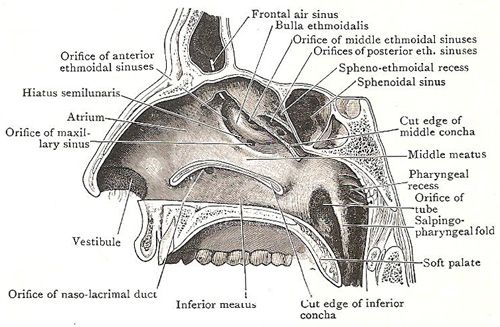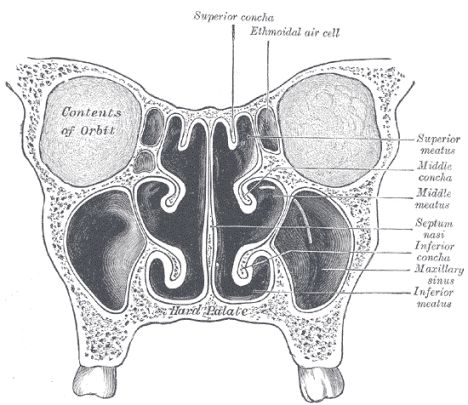Friday 10th of January 2014 at Studio Mutin, Brussels, Belgium.
Participants: Sandra Vincent, Maya Dalinsky, Sonia Si Ahmed, Rhaissa D'haene , Eva Maes and Anouk Llaurens.
- Introductions of the documentation on the IDOCDE web site: (audio1)
- Introduction of the workshop: what is still present from past workshops? Sandra Vincent, Maya Dalinsky, Anouk Llaurens, Sonia Si Ahmed, Eva Maes, Rhaissa D 'haenne. (audio 2)
Eva Maes (morning): In the first two workshops we attended to the skin in relation to the sense of touch, to the vestibular structures in relation to proprioception and to the sense of taste. Continuing this exploration, in the third workshop we will be working around the sense of smell, and investigating how the mouth together with the nose have been establishing 'reaching capacities'.
1. Introduction of the BMC® proposal: (audio 3) two explorations to create space; Exploration 1: revisiting yielding and cellular breathing; Exploration 2: exploring internal space of the nasal cavity and relation to the mouth and mouthing pattern.
2. Feedbacks after exploration 1: (Audio 4) Eva, Anouk, Sonia, Maya, Rhaissa, Eva, Rhaissa, Eva, Anouk, Eva, and Sandra. Some topic that came up: fluids passing though a membrane, lightness, compression, relation ship between reality and imagination, front and back of the body, capacity for meeting, relaxation and tonus, allowing myself to rest.
3. Nasal cavity through anatomical documents: (audio 5 + images) nasal cavity as a space to lighten the head, to modulate temperature, as a resonance space for the voice. Relation between mouth and noes for survival to get food and to escape from danger.
4. Exploration 2: (audio 6) with a partner, cellular breathing, rooting reflex, tracing the bones, holding the crane.
5. Feedbacks after exploration 2: (audio 7) Sonia, Anouk.
Anouk Llaurens' proposal (afternoon): For this third workshop we will go on with the practice of “the two sides of touch”, using the environment to get to know ourselves and ourselves to get to know our environment. Other vocal calls like “reverse” or ‘repeat’ will be introduced to our practice in addition to the one used in previous workshops (open, close, pause, report). Tasting our sensations and measuring the life spend of our experiences will support the emergence of compositions in time and space. Writing and drawing will be used as reflexive tools for documenting, integrating and sharing our experience with the others.
1. Ten minutes sitting: attention on air entering and exiting the noes and the nasal cavity.
2. Exploration: (audio 8) The two sides of touch with the environment - what is the environment? - identify your interest and follow it - Auto stimulation - you don't have to be polite - exploration/ composition.
3. Documentation of the experience: (audio 9) a) Revisit your experience through drawing with eyes closed and/or through writing. Past but present at the same time. What are your strategies? How does your memory works? b) Teaching each other: use the drawing as a document to talk about you experience and share it.
4. Sharing of the experience (audio 10 to 18): Anouk: (audio 10): introduction - Eva (audio 11): En route vers la satisfaction - Maya (audio 12): Two questions - Sonia (audio 13): Beauty - Sandra (audio 14): Honoring my laziness - Rhaissa (audio 15): Timeless - Eva and Anouk (audio 16): Individual and collective - Anouk (Audio 17): beginner's mind- Anouk (audio 18): Unexpected.
-
Note about the downloaded documents (audio, drawings and texts)
Audio coming from Eva Maes' session are first and Anouk Llaurens session second. Don't hesitate to scroll down to have access to all of them. Some are about the explorations proposed and other are feedbacks from all participants. They are named so you can choose theme that call you. The feedbacks are individual testimonies of a collective experience. For Anouk ‘s framed feedback (sharing of documents) you have the possibility to simultaneously listen to the audio and look at the drawings that are presented in "order of appearance”: Eva Maes, Maya Dalinsky, Sonia Si Ahmed, Sandra Vincent, Rhaissa D'haene, Eva and Anouk, Anouk.
This co-teached workshop (Anouk Llaurens & Eva Maes) is the third one of a series that investigates the spectrum of the senses. We want to offer an in-depth exploration, based on the approach of Body-Mind Centering® as well as on Lisa Nelson “Tuning Scores”. It is a prolongation of an already existing relationship, as one important support for the development of Lisa Nelson work were her meetings with Bonnie Bainbridge Cohen in the 70. On the other hand, Lisa Nelson, being the main editor of Cohen's 'Sensing Feeling Action', has been an invaluable force to help articulating and making visible 'BMC approach'. Both Body-Mind Centering as ‘Tuning Scores’ are embedded in a broader scientific and artistic research oriented to highlight our physical base, for the sake of exploration, but also with the possible consequence of opening new avenues for improvisation, composition, inspiration...
To build a sense of continuity, a documentation of the workshops based on audio recordings, drawings, images, anatomical documents and referential texts, will unfold on the IDOCDE web site (International Documentation Of Contemporary Dance Education).

















